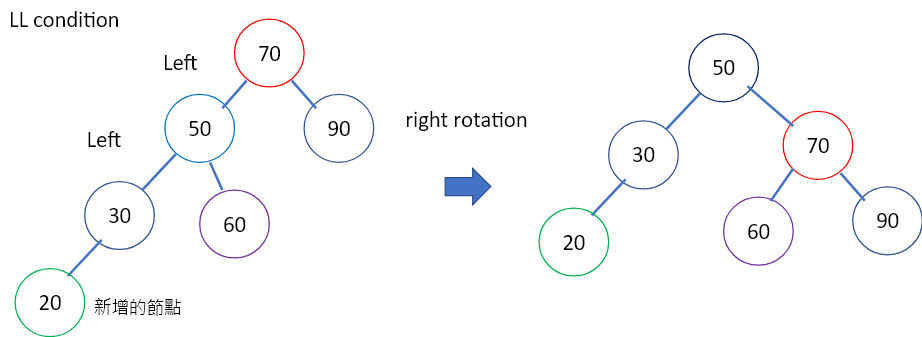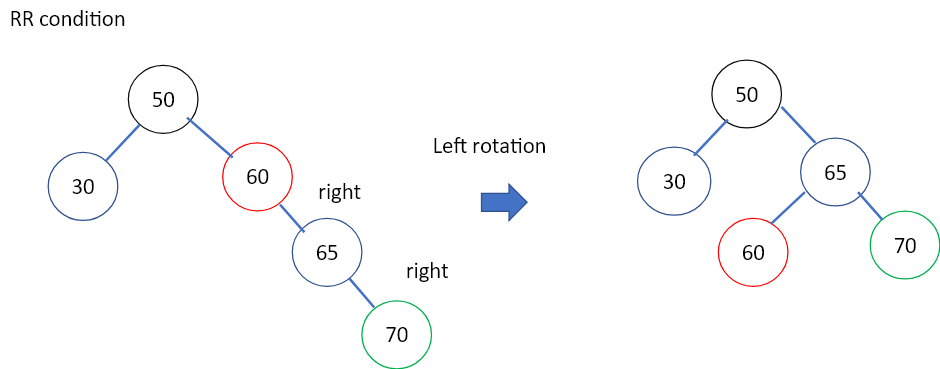AVL 樹是一種會自我平衡的二元搜尋樹(Binary Search Tree,見兩天前文章),對每一個節點來說,左右兩邊的高度差(height difference)要小於等於1,如高度差大於1,節點會旋轉(rotate)直至樹平衡(balance)。
加入新節點後,依不平衡的狀況又分為LL(left-left condition)、LR(left-right condition)、RR(right-right condition)、RL(right-left condition)。這裡用圖加程式碼說明可能會比較容易理解:
首先來講left-left condition:
圖1.加入的新節點根據二元搜尋樹的規則,會在node30的left child,但這樣會造成node70不平衡(imbalance)(因為左側高度為3,右側高度為1,高度差為2。)因為不平衡點在左側,然後插入的節點也在左邊子樹的左側,故我們稱之為left-left condition或LL condition(直翻叫左左情況,聽起來有點過於俏皮,我們在本篇就使用LL代替)。此時我們要對離新增節點最近的不平衡點做右旋,也就是node70。node70的左邊先改接上node50 right child,node50的right child再接上node70。右旋寫作程式碼如下,可能會比看圖容易理解:
def right_rotate(node):
new_root=node.leftchild
node.leftchild=node.leftchild.rightchild
new_root.rightchild=node

圖2.加入的新節點根據二元搜尋樹的規則,會在node65的right child,但這樣會造成node60不平衡(left.height=0, right.height=2,balance=2大於1)。由於不平衡點在右側,然後插入的節點也在不平衡點rightchild的右側(見圖),故為right-right condition(or RR condition)。此時我們要對離新增節點最近的不平衡點做左旋,也就是node65。左旋寫作程式碼如下,和右旋差不多,左右相反而已:
def left_rotate(node):
new_node=node.rightchild
node.rightchild=node.rightchild.leftchild
new_root.rightchild=node
接著我們來看LR condition:
圖3.加入的新節點根據二元搜尋樹的規則,會在node30的right child,但這樣造成node40不平衡。由於新增節點在不平衡節點left child的右邊,故為left right condition (LR condition)。這種情況,我們要先對node30做左旋,讓這個不平衡變成LL condition,再對node40做右旋。
同理RL condition也是類似的方法:
圖4.加入的新節點根據二元搜尋樹的規則,會在node70的left child,但這樣造成node60不平衡。由於新增節點在不平衡節點right child的左邊,故為right left condition (RL condition)。這種情況,我們要先對node70做左旋,讓這個不平衡變成LL condition,再對node60做右旋。
那下面我們就來看完整的程式碼吧~
# 一樣,因為我們要用level-order traversal來檢查我們的樹長怎麼樣了,所以還是import個deque module
from collections import deque
# for AVL tree 因為我們需要根據左右樹的高度差來判斷是否平衡,這裡我們給每個node多一個高度的屬性3
# time:O(1), space: O(1)
class TreeNode:
def __init__(self, data=None):
self.data = data
self.leftchild = None
self.rightchild = None
self.height = 1
# 來個大家最熟悉的level-order traversal,用來檢查樹看起來怎麼樣了
# time: O(n), space: O(n)
def levelordertraversal(rootNode):
customqueue = deque()
customqueue.append(rootNode)
while len(customqueue) != 0:
popped = customqueue.popleft()
print(popped.data)
if popped.leftchild is not None:
customqueue.append(popped.leftchild)
if popped.rightchild is not None:
customqueue.append(popped.rightchild)
# 取得節點高度,為了避免在沒有節點的狀況(node==None),程式出現error,這裡先定義好return 0
# time:O(1), space: O(1)
def getHeight(node):
if not node:
return 0
else:
return node.height
# 先把計算高度差做成function,等等程式不至於看起來很雜亂
# time:O(1), space: O(1)
def getbalance(node):
if not node:
return node
else:
return getHeight(node.leftchild)-getHeight(node.rightchild)
# 右旋,旋轉後要重新計算高度,回傳新的root
# time:O(1), space: O(1)
def rightrotate(node):
new_root = node.leftchild
node.leftchild = node.leftchild.rightchild
new_root.rightchild = node
node.height = 1+max(getHeight(node.leftchild), getHeight(node.rightchild))
new_root.height = 1+max(getHeight(new_root.leftchild),
getHeight(new_root.rightchild))
return new_root
# 同理左旋
# time:O(1), space: O(1)
def leftrotate(node):
new_root = node.rightchild
node.rightchild = node.rightchild.leftchild
new_root.leftchild = node
node.height = 1+max(getHeight(node.leftchild), getHeight(node.rightchild))
new_root.height = 1+max(getHeight(new_root.leftchild),
getHeight(new_root.rightchild))
return new_root
# 插入節點: time:O(logn), space:O(logn)
def insertNode(rootNode, value):
if rootNode is None:
rootNode = TreeNode(value)
return rootNode
elif value < rootNode.data:
rootNode.leftchild = insertNode(rootNode.leftchild, value)
elif value > rootNode.data:
rootNode.rightchild = insertNode(rootNode.rightchild, value)
rootNode.height = 1+max(getHeight(rootNode.leftchild),
getHeight(rootNode.rightchild))
balance = getHeight(rootNode.leftchild)-getHeight(rootNode.rightchild)
# left-left condition
if balance > 1 and value < rootNode.leftchild.data:
return rightrotate(rootNode)
# left-right condition
elif balance > 1 and value > rootNode.leftchild.data:
rootNode.leftchild = leftrotate(rootNode.leftchild)
return rightrotate(rootNode)
# right-right condition
if balance < -1 and value > rootNode.rightchild.data:
return leftrotate(rootNode)
# right-left condition
elif balance < -1 and value < rootNode.leftchild.data:
rootNode.rightchild = rightrotate(rootNode.leftchild)
return leftrotate(rootNode)
return rootNode
# 跟Binary search tree一樣找local min,給delete node function準備的
def findlocalmin(node):
current = node
while current.leftchild is not None:
current = current.leftchild
return current
# 刪除節點,前面的部分和二元搜尋樹一樣,後面多了balance的部分,概念大同小異
# time:O(logn), space:O(logn)
def deleteNode(rootNode, value):
if not rootNode:
return rootNode
elif value < rootNode.data:
rootNode.leftchild = deleteNode(rootNode.leftchild, value)
elif value > rootNode.data:
rootNode.rightchild = deleteNode(rootNode.rightchild, value)
else:
if rootNode.rightchild is None:
rootNode = rootNode.leftchild
return rootNode
elif rootNode.leftchild is None:
rootNode = rootNode.rightchild
return rootNode
else:
temp = findlocalmin(rootNode.rightchild)
rootNode.data = temp.data
rootNode.rightchild = deleteNode(rootNode.rightchild, temp.data)
rootNode.height = 1+max(getHeight(rootNode.leftchild),
getHeight(rootNode.rightchild))
balance = getbalance(rootNode)
# again we have to balance the tree
# LL condition
if balance > 1 and getbalance(rootNode.leftchild) > 0:
return rightrotate(rootNode)
# LR condtion
elif balance > 1 and getbalance(rootNode.leftchild) < 0:
rootNode.leftchild = leftrotate(rootNode.leftchild)
return rightrotate(rootNode)
# RR condition
elif balance < -1 and getbalance(rootNode.rightchild) < 0:
return leftrotate(rootNode)
# RL condition
elif balance < -1 and getbalance(rootNode.rightchild) > 0:
rootNode.rightchild = rightrotate(rootNode.rightchild)
return leftrotate(rootNode)
else:
return rootNode
讓我們直接測試看看吧!
AVL = TreeNode(50)
AVL = insertNode(AVL, 30)
AVL = insertNode(AVL, 60)
AVL = insertNode(AVL, 65)
AVL = insertNode(AVL, 70)
levelordertraversal(AVL)
>> 50
30
65
60
70
AVL = deleteNode(AVL, 30)
levelordertraversal(AVL)
>> 50
65
60
70
參考資料:
這篇寫得真的不錯,寫得蠻清楚的:
https://josephjsf2.github.io/data/structure/and/algorithm/2019/06/22/avl-tree.html
The Complete Data Structures and Algorithms Course in Python (Udemy)

 iThome鐵人賽
iThome鐵人賽
 看影片追技術
看更多
看影片追技術
看更多